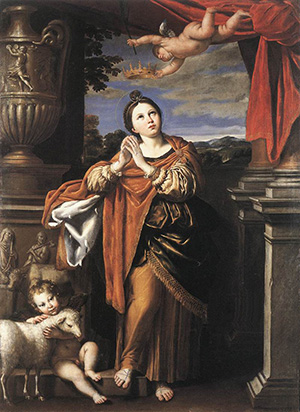Saint Agnes
Feast Day January 21

“A new kind of martyrdom!” exclaimed St. Ambrose, bishop of Milan. The assembly cheered and applauded. He was celebrating St. Agnes because she was a virgin, a martyr—and a child. She was executed at Rome in 304 during the Emperor Diocletian’s vicious persecution. Here are Ambrose’s observations on her death:
St. Agnes is said to have suffered martyrdom at age 12. The cruelty that did not spare so young a child was hateful, but the power of faith in the child was greater. Was there room for a wound in that small body? The sword could barely strike her, yet she had the inner strength to strike back. Girls of her age usually can’t even bear a parent’s angry glance. They cry at needles’ pricks as though they were wounds. Agnes, however, faced her persecutors fearlessly. When they attempted to force her to worship at the pagan altars, she stretched out her hands and made the sign of the cross over the sacrificial fires. She was not fazed by the heavy weight of the chains they wrapped around her. And she freely offered her body to the executioner’s sword.

The executioner used both threats and allurements to try to change her mind. He encouraged young men to beg her to marry them. But she answered, “I already have a spouse, and I will not offend him by pretending that another might please me. I will give myself only to him who first chose me. So, executioner, what are you waiting for? Destroy this body that unwanted eyes desire.”
Agnes stood and prayed. Then she bent down her neck. The executioner trembled as though he himself had been condemned. His right hand shook and his face grew pale, but the virgin showed no fear at all.
So in one victim we have a twofold martyrdom of purity and faith, for Agnes both remained a virgin and also obtained martyrdom. Historians say that legends have embroidered the few facts we know about Agnes. But the stories are rooted in actual events and convey kernels of truth about her. These legends tell that Agnes was a beautiful and soon-to-be-marriageable young woman. Many eager young men pursued her, but she rebuffed them because she had consecrated her virginity to Christ.
One spurned suitor took revenge by reporting to the authorities that Agnes was a Christian. She was brought before a judge who tried to persuade her to recant. He threatened her with fire and torture, but she did not flinch. Then he had her stripped at a brothel and urged young men to seduce her. “You may stain your sword with my blood,” she said, “but you will never profane my body that I have consecrated to Christ.” All were so stunned by her presence that only one boy tried to touch her. Legend says he was struck blind, and that Agnes healed him.
Exasperated and egged on by her first accuser, the governor ordered her execution. Agnes was taken to the Stadium of Domitian, where she courageously faced a nervous soldier who hacked her to death with his sword. Over the centuries the little virgin martyr became one of the most popular saints in Christian history.
St. Agnes’s death was “a new kind of martyrdom!” She taught us adults the meaning of valor while she was still a child. Agnes hurried to the place of her execution more joyfully than a bride goes to her wedding. And she was adorned not with plaited hair, but with Christ himself.

from Voices of the Saints by Bert Ghezzi

